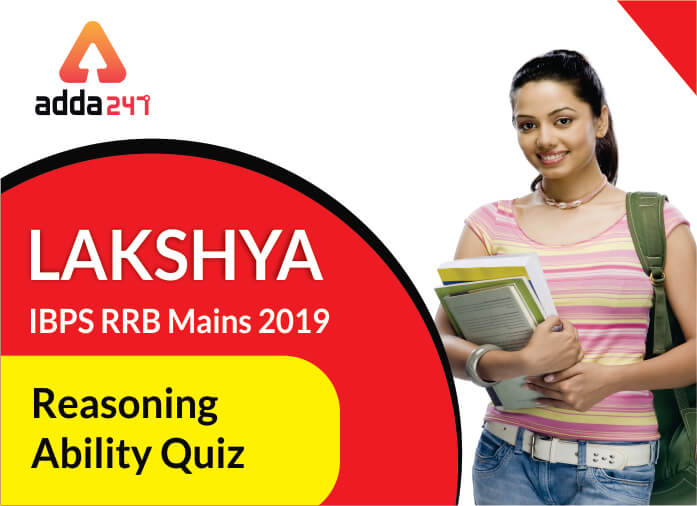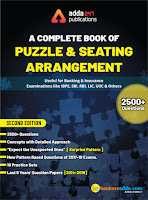IBPS RRB PO/Clerk Reasoning Quiz
The reasoning is an important part of a banking examination that holds the key for scoring well. This section tests the logic of a person while solving the questions. A good score depends on the clarity of your logical ability to crack the pattern of the question. This can only be attained if you practice daily without fail. For the IBPS RRB Mains 2019 Study Plan and also for the upcoming banking examinations including SBI Clerk, LIC ADO, IBPS PO, IBPS Clerk and all the others which are not yet officially announced like the RBI Grade B and the RBI Assistant 2019.
Here is IBPS RRB PO/Clerk Mains Reasoning quiz for 8th of September 2019 and it includes questions from Puzzle, Data Sufficiency, Logical.
Directions (1-5): On the basis of the information given below, answer the following questions.
Six persons are sitting around a circular table. They belong to six different countries i.e. India, China, Germany, France, Russia and Japan but not necessarily in the same order. Also each person likes different subjects i.e. Physics, Chemistry, Economics, Medicine, Peace and Literature but not necessarily in the same order. The persons who like Medicine, Economics and Peace are neither from Japan nor from India. The persons who belong to France and China likes neither Medicine nor Literature. A is neither from Japan nor sits on the immediate left of the person who likes Chemistry. The only person, who is between E and F, likes Physics. The one who likes Medicine is sitting opposite the person, who belongs to Russia. While the person, who belongs to China sits on the immediate left of the person, who likes peace. The person who is on the left side of the person from Japan does not like Literature. D likes Chemistry and belongs to China and he is facing the person who likes Physics. The one who likes Literature sits on the immediate right of the person, who belongs to Japan but on the immediate left of the person who likes Economics. C does not like Economics and F does not like Medicine. B is one of the persons.
Q1. Who likes Chemistry?
(a) The person who is sitting to the immediate left of B
(b) The person who is sitting to the immediate right of A
(c) The person who is sitting opposite to the person, who likes Physics.
(d) The person, who belongs to Japan.
(e) Both (c) and (d)
Q2. The person who sits between E and D is(to the left of E)?
(a) Second to the left of the person, who belongs to India.
(b) Second to the right of the person, who belongs to Japan.
(c) Fourth to the left of the person, who belongs to Russia.
(d) Second to the right of the person, who likes literature.
(e) None of these
Q3. Who is sitting on the immediate right of the one, who likes Literature?
(a) D
(b) E
(c) B
(d) F
(e) None of these
Q4. The one who like Medicine sits?
(a) On the immediate left of the person, who belongs to France.
(b) On the immediate right of the person, who belongs to Japan.
(c) On the opposite of the person, who likes Economics.
(d) On the opposite of the person, who belongs to Russia.
(e) Both (c) and (d)
Q5. Who is sitting on third to the left of second to the right of the person, who belongs to France?
(a) B
(b) A
(c) C
(d) E
(e) None of these
Solutions (1-5):
S1. Ans.(c)
S2. Ans.(c)
S3. Ans.(c)
S4. Ans.(e)
S5. Ans.(e)
Directions (6-10): Each of the questions given below consists of a question and two statements numbered I and II. You have to decide whether the data provided in the statements are sufficient to
Q6. What is the distance between point A to point D?
I. A person faces north direction and starts walking from point A, he walks 10km to his right after that he takes left turn and walks 7000m again he walks 2km towards his right. Finally he takes right turn walks 2km and reached at point D.
II. A person faces north direction and turns 90° from point A in anticlockwise direction and walked 10km. After that he takes left turn and walks 8km. Finally he takes right turn walks 2km and reached at point D.
(a) If statement I alone is sufficient to answer the question, but statement II by itself is not sufficient to answer the question.
(b) If statement II by itself is sufficient to answer the question, but statement I alone is not sufficient to answer the question.
(c) If statement either I or II is sufficient to answer the question.
(d) If both the statements I and II taken together are not sufficient to answer the question.
(e) If both the statements I and II taken together are sufficient to answer the question.
Q7. What is the code for ‘sky’ in a code language?
I. In that language `jo ko ni sa’ means ‘Sky is the limit’ and ‘jo to ni ja’ means ‘Sky color is blue’.
II. In the same language ‘jo ko ta na’ means ‘Sky has no limit’.
(a) If statement I alone is sufficient to answer the question, but statement II by itself is not sufficient to answer the question.
(b) If statement II by itself is sufficient to answer the question, but statement I alone is not sufficient to answer the question.
(c) If statement either I or II is sufficient to answer the question.
(d) If both the statements I and II taken together are not sufficient to answer the question.
(e) If both the statements I and II taken together are sufficient to answer the question.
S7. Ans.(e)
Sol. From Statement- I, we can find that ‘Sky is’ coded as ‘jo ni’.
From Statement – II, we can find that ‘Sky limit’ is coded as ‘jo ko’.
When we combine both statements we can find that ‘Sky’ is coded as ‘jo’.
Q8.How many daughters A have?
I. Only five members in a family. G has only one son, A has only 2 children. G is daughter-in-law of S. S is father of A.
II. G has 2 children. A is husband of G. S is son of A.
(a) If statement I alone is sufficient to answer the question, but statement II by itself is not sufficient to answer the question.
(b) If statement II by itself is sufficient to answer the question, but statement I alone is not sufficient to answer the question.
(c) If statement either I or II is sufficient to answer the question.
(d) If both the statements I and II taken together are not sufficient to answer the question.
(e) If both the statements I and II taken together are sufficient to answer the question.
S8. Ans.(a)
Sol. From Statement- I, it is clear that G has only one son, and A has only 2 children, G and A are husband and wife. Hence A has only one daughter.
From Statement –II, we can’t find how many daughters A has.
Q9. Among A,B,C,D and E. who among the following person is the greatest?
I.B is less than only 2 persons. A is greater than B. C is greater than E.
II. Both C and E are less than A. C is less than B. A is greater than only three persons
(a) If statement I alone is sufficient to answer the question, but statement II by itself is not sufficient to answer the question.
(b) If statement II by itself is sufficient to answer the question, but statement I alone is not sufficient to answer the question.
(c) If statement either I or II is sufficient to answer the question.
(d) If both the statements I and II taken together are not sufficient to answer the question.
(e) If both the statements I and II taken together are sufficient to answer the question.
S9. Ans.(e)
Sol. We can find that A is greatest from both the statements taking together.
Q10. Find the number of boys and number of girls in the row?
I. R sits 16th from left end of the row and Y sits 8th from the right end of the row. R and Y interchange their positions, after interchanging the position R’s position is 20th from left end.
II. Boys and girls are in the ratio of 6:3. All are seated in a row and facing towards north.
(a) If statement I alone is sufficient to answer the question, but statement II by itself is not sufficient to answer the question.
(b) If statement II by itself is sufficient to answer the question, but statement I alone is not sufficient to answer the question.
(c) If statement either I or II is sufficient to answer the question.
(d) If both the statements I and II taken together are not sufficient to answer the question.
(e) If both the statements I and II taken together are sufficient to answer the question.
S10. Ans.(e)
Sol. From Statement- I, after interchanging the position, R’s position will be 8th from right end and his position is given from left end that is 20th. Hence total number of persons in a row= 20+8-1= 27 persons
From Statement-II, Boys and girls ration is given 6:3. Let boys= 6x and girls=3x
6x+3x= 27, hence x=3. So boys are 18 and girls are 9.
Directions (11-13): Each of the following questions consists of a statement followed by two arguments I and II.
Q11.
Statement: Should officers accepting bribe be punished?
Arguments:
I. No. Certain circumstances may have compelled them to take bribe.
II. Yes. They should do the job they are entrusted with, honestly.
(a) if only argument I is strong
(b) if only argument II is strong
(c) if either I or II is strong
(d) if neither I nor II is strong
(e) if both I and II are strong.
S11. Ans.(b)
Sol. Clearly, officers are paid duly for the jobs they do. So, they must do it honestly. Thus, argument II alone holds.
Q12.
Statement: Should India become a permanent member of UN’s Security Council?
Arguments:
I. Yes. India has emerged as a country which loves peace and amity.
II. No. Let us first solve problems of our own people like poverty, malnutrition.
(a) if only argument I is strong
(b) if only argument II is strong
(c) if either I or II is strong
(d) if neither I nor II is strong
(e) if both I and II are strong.
S12. Ans.(a)
Sol. A peace – loving nation like India can well join an international forum which seeks to bring different nations on friendly terms with each other. So, argument I holds strong. Argument II highlights a different aspect. The internal problems of a nation should not debar it from strengthening international ties. So, argument II is vague.
Q13.
Statement: Should the persons below the age of 18 years be allowed to join armed forces?
Arguments:
I. No. Persons below the age of 18 do not attain both physical and mental maturity to shoulder such burden.
II. Yes, this can makes our army more powerful.
(a) if only argument I is strong
(b) if only argument II is strong
(c) if either I or II is strong
(d) if neither I nor II is strong
(e) if both I and II are strong.
S13. Ans.(a)
Sol. The armed forces must consist of physically strong and mentally mature individuals to take care of defence properly. So, argument I holds strong. Clearly, argument II holds no relevance.
Directions (14– 15): Study the following instructions carefully and then answer the questions that follow.
Q14.
Statement: Many people living in the slums of western part of the town are diagnosed to be suffering from malaria.
Courses of Action:
I. The municipal corporation should immediately provide compensation of 10000 rs. to every patient suffering from malaria.
II. The municipal authority should immediately make necessary arrangements to provide quick medical help to the affected people.
III. The municipal authority should take steps to shift all the people staying in the slums of western part of town to other areas.
(a) Only I follows
(b) Only II follows.
(c) Only I and III follow.
(d) Only I, II and III follow.
(e) None of these
S14. Ans. (b)
Q15.
Statement: Many teachers of the local school have rendered their resignation to the principal to protest the management’s decision for not implementing revised pay scales.
Courses of Action:
I. The school management should accept the resignations and appoint new teachers.
II. The school management should persuade the teachers to continue with an assurance of considering the pay hike issue.
III. The school management should approach the govt. for guidelines.
(a) None follows
(b) Only either I or II follows.
(c) Only III follows.
(d) Only I follows.
(e) Only II follows.
S15. Ans. (c)
Sol. All the three courses of action, only III looks appropriate because the school management should approach government guideline.









 GA Capsule for SBI Clerk Mains 2025, Dow...
GA Capsule for SBI Clerk Mains 2025, Dow...
 The Hindu Review October 2022: Download ...
The Hindu Review October 2022: Download ...
 Bank of Baroda LBO Recruitment 2025 Noti...
Bank of Baroda LBO Recruitment 2025 Noti...


